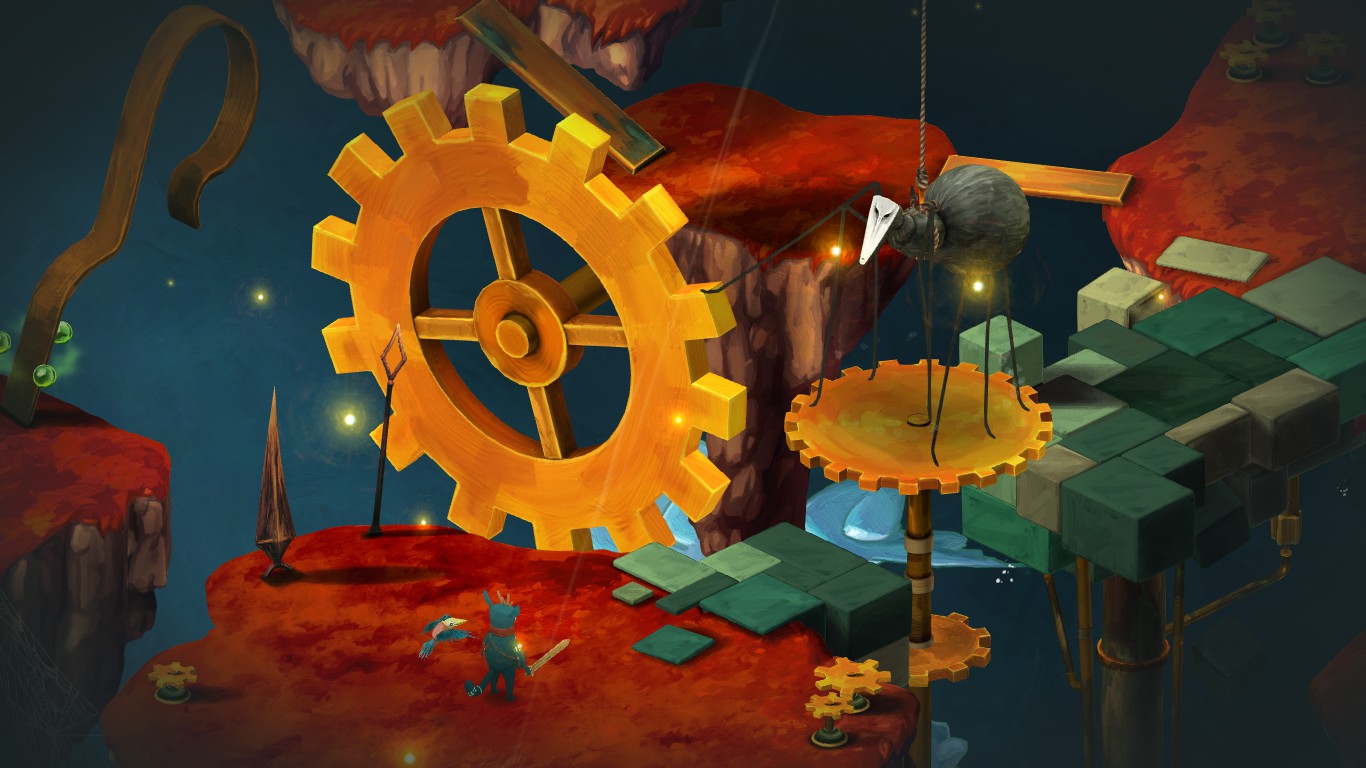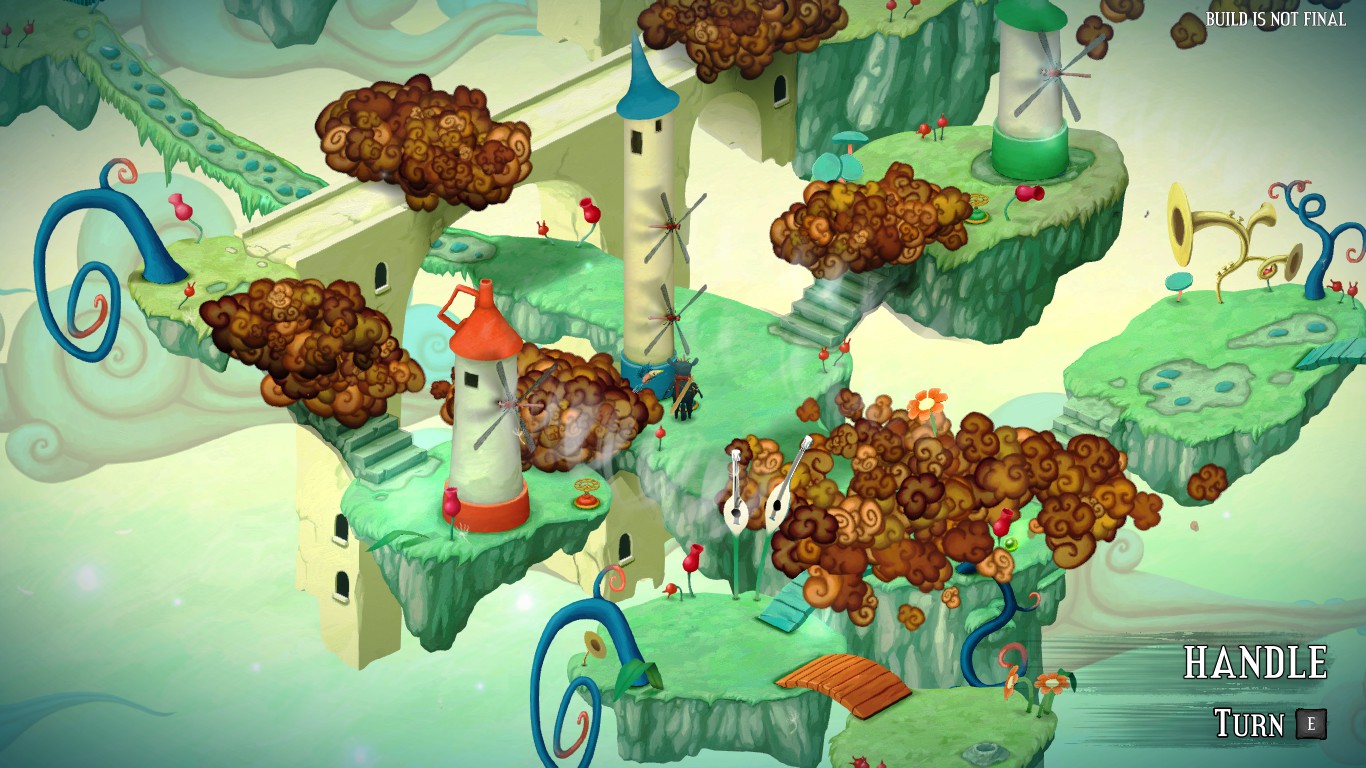Preview | Figment
A little bit of darkness can be an awful lot of fun. This is the case for Figment, a delightful action-adventure game being brought to us this summer by Bedtime Digital Games, the creators of Chronology and Back to Bed. Much like their previous titles, Figment also relies on puzzles to progress through the game, but marks itself out from the others by including hack’n’slash mechanics.
The introduction begins in tragedy: a disaster implied by speech, but not explained nor shown. A girl and her family are torn apart, but you don’t know how or why. Just as you expect to be shown the aftermath of this, no matter how many weeks or years later, you wake up in a surreal world. It doesn’t take long to figure out that this is the mind, far separated from any events in reality — yet the mystery of the past remains.
And so we are introduced to the main characters: Dusty and Piper. Unaware of recent events, Dusty has embraced a grumpy existence, but Piper (a small bird) offsets his gloom with her cheery chatter and the two play off each other with a witty repertoire that continues throughout the story. Piper also acts as the voice of the tutorial, in the way that only someone who has to deal with continual apathy can.

It soon becomes clear that the mind isn’t safe from everything and it’s Dusty’s job, as the out-of-action Voice of Courage, to put things right. There’s no explanation for why Dusty put down his sword, but it hints at the greater state of the mind, especially as he takes it up once more.
A nightmare drops into Dusty’s home, takes his possessions and gives him a personal reason to set out after him. But what the nightmare says belies the real matter for concern: ‘Eventually, we all lose everything’. This ties back all the way to the disaster, suggesting the nightmare is here and the mind corrupted as a consequence of the event. This nightmare is one of many that you have to give chase to and, as with all of them, it will throw obstacles into a path already filled with puzzles.
Most importantly, the villains sing, but we’ll save the best until last.

Getting to the villains involves solving puzzles along your way. For the most part, this is a simple case of remembering where everything is in your mind (or the mind) and piecing individual parts together. In a lot of ways, it’s similar to puzzle-solving in a point-and-click game — a battery needs to be removed from one place to operate a piece of machinery in another or a disc has to be fitted to a piston to turn it into a working lift. By giving a button a satisfying kick (in grumpy Dusty’s style), you can activate moving platforms and move bridges, among other things.
You’re introduced to the controls (which support controller input) via a series of short and unobtrusive tutorial prompts. They’re nice and straightforward, which means more effort can be spent on the puzzle-solving and combat portions of the game. It also looks like you may be able to customise them, but the settings don’t currently recognise key inputs. Puzzles are solved, for the most part by interacting with objects, whereas combat consists of hitting things (with a fair amount of strategy thrown in when it comes to avoiding attacks and discovering weaknesses or abilities).
The fact that the puzzles involve a bit of backtracking isn’t too much of an issue, as there tends to be a sort of ‘central location’ acting as a go-between between various offshoots. However there are a few collectibles which unlock forgotten memories (in the form of captioned images) that seem to require more backtracking, through various levels, in fact, to reach. Since there’s no option to fast-travel between different (pre-visited) islands or locations when you leave an area, walking back through every level could become tedious.
At this point we have to mention how gorgeous the art is in Figment. All hand-drawn, the surreal landscape of the mind looks a charm. Each area has a unique feel to it, with a lot of little pieces of scenery adding to the thematic whole. The animations are especially good. Pencil bridges dip as you walk over them and really add to the magic of the world as you move through it. It goes as far as to reinforce Dusty’s personality by having him kick buttons instead of pressing them. Even the user interface fits in with the overall look of the game.

As you progress further through the mind, you encounter its residents. All of them are barricaded in their homes, but it’s amazing how even they manage to show personality and embellish the characteristics of the area you’re in. The voice acting for them and all other characters is surprisingly good.
We mentioned earlier that the villains sing — this they do, and it’s one of the best aspects of the game. Each villain represents a different ailment of the brain, each has a different method of attack and each has its own style of singing. From the rocky undertones of the Fear of Loss to the revolting rhymes of the Plague Man, it’s worth holding back in boss fights just so you get to hear the songs in their entirety.
The music outside of villain encounters is great as well, cleverly crafted and paired with sound effects to resemble the area they play in. In the rainy area at the beginning, the sound of dripping water plays in the same rhythm as the music (which is good in itself). In the creative area of the brain, plants that look like musical instruments add relevant overlays to the current music when you walk near them.

The puzzles never grow old, as new mechanics are introduced with each location, getting more difficult at a reasonable rate along with combat, where each new enemy has a new way of attacking you. Of note in the Plague levels, you can change the direction of windmills to move harmful gas out of the way. Dying isn’t too much of a problem because the game autosaves at regular intervals and returns you to the latest save if you run out of health.
Health can be restored by striking green endurance neurons down from trees and collecting them and there are more than enough to go around. It is possible to upgrade the amount of health you have by collecting endorphins, which are released by the brain every time you do well (for instance defeating an enemy or completing a puzzle). Within the story, it’s explained that they’ll get Dusty back to his former self.
There are a few issues in the current build, such as boss fights breaking if you stand around too long doing nothing but dodging their attacks, moving platforms not quite working properly and blocking collectibles and being blocked off from the way you came (although the last two may be intentional), but only a few select levels of the game were available and it’s likely the release version will have all of these problems ironed out. With any hope there will at least be an option to save the game, as the preview build did not have this (much to our dismay).
So if you fancy an all-singing, all-dancing trip quite literally down memory lane, Figment is the title to keep an eye on. With lovable characters, an unsolved mystery and a brilliant world to walk around, it holds a lot of promise.
Comments are closed.